ABSTRACT:
The global customer care industry is multiplying with a strong focus on enhancing the customer experiences. Customer care departments are adopting various measures to handle customer grievances efficiently. In addition, technological upgrades, redesigning the business processes, etc., assist the customer care industry in combating the business challenges.
Consumers' shift toward digital channels has led to increased competition in the industry. Brands with excellent customer care services are getting a massive spike in their sales and brand image. High hassle time, irrelevant call and website diverts, ill-informed staff, etc., are a few problems commonly experienced by the consumers. Brands are also aware of such issues and utilize the latest technologies such as AI, VR, ML, communication technologies, etc., to ensure positive customer experiences.
This research titled: 'Global Customer Care Industry: Trends, Consumer Shifts, and Challenges' by GoodFirms analyzes the customer perceptions and shifts, current trends, and challenges in the global customer care industry. GoodFirms conducted an online survey between 1st July 2022 and 20th July 2022. A total of 270 responses were collected. Participants, including end users from all over the world, shared their experiences and problems interacting with customer care and support. This research also brings valuable insights into how the customer care industry is evolving and highlights the key challenges impacting this industry.
Table of Contents:
Introduction
Global Customer Care Industry - Market Outlook
#Consumer Trends in Global Customer Care Industry
- Phone is the Most Preferred Channel to Connect with Customer Care and Support
- 25.9% Surveyees Prefer Phone Over any other Medium to Reach Customer Care
- 22.2% of Surveyees Prefer Live Support Over Any Other Medium
- Email is the preferred choice of 10.1% of respondents, mostly between 25-39
- 11% of Respondents Use Self-Service tools to Resolve their Issues
- 17.4% Stated That They Prefer Virtual Assistants When it Comes to Connecting With Customer Support
- 29.6% Prefer to Fix Minor Issues by Conducting Secondary Research on the Internet and User Manuals
- Responsive Customer Services Are Bringing a Change
- Digital Platforms are Leading in Customer Care Services
- Personalized Customer Experiences are Here to Stay
Top Changes Customers Would Like to See in Customer Care Services
- 55.6% Suggested Omnichannel Customer Support
- 25.9% of Surveyees Desire to Experience Video Chat Assistance
- 48.1% of Respondents are Expecting More Feedback and Recommendation Options
Consumer Shifts in 2022
Challenges in Customer Care Industry
- Tackling Customer Disengagement
- The Rising Cost of Customer Support Practices and Maintenance Tools
- Dealing With Demanding Customers/Managing Expectations
- Staying Conversant With New Technologies and Trends
- Inadequate Training and Poor Knowledge Among Representatives
- Lack of Standard Operating Procedures
- Taking too Much Time for Resolutions
Introduction
Customer care services are direct one-on-one interactions between the customers and the business representatives. These interactions help any business in brand empowerment, customer satisfaction, retention, etc., due to which the global customer care industry is flourishing rapidly.
Elevating customer experience is an ongoing and ever-evolving journey for any business. Aligning the long-term business goals with the customers' current and future requirements is challenging. Undoubtedly, customer care and customer support are crucial components of all businesses to ensure maximum customer satisfaction. The rising technologies like automation, machine learning, artificial intelligence, etc., stands as the top-most factor in boosting the growth of the global customer care industry. Digital platforms, AI bots, FAQs, etc., are being used to interact with consumers quickly, but human interactions are still necessary for addressing customers' queries. The majority of the brands either have their in-house teams or are outsourcing their customer care practices
The customer care industry is rapidly ramping its business activities and infrastructure to reduce the growing costs, improve customer experience, and prevent other challenges. Brands gain insights from feedback and interaction touchpoints to efficiently address the customers' queries.
This survey by GoodFirms titled: 'Global Customer Care Industry: Trends, Consumer Shifts, and Challenges' attempts to identify and analyze the current trends, consumer preferences, and challenges of the global customer care industry. The research aims to help consumers and customer services professionals get valuable insights to improve their customer care practices for expanding the business further and attaining a more profitable regime. In addition, this research also explores the challenges impacting the 'service delivery' of customer care teams and businesses.
Global Customer Care Industry - Market Outlook
The global customer care and service industry was valued at around 8.79 billion in 2021. It is expected to grow with an average CAGR rate of 18.1% in the upcoming years.(1) The growing necessity of determining customer preferences and behavior is one of the core drivers of this industry at the global level.
Different brands employ strategies such as automation, increasing digital presence, regular interactions, customer engagement, etc., to ensure customer satisfaction and improved experience. Amidst the chaos caused by the pandemic, companies shifted their customer service centers to home setups. The customer service efficiency in this instance saw a mixed impact.. While some remotely working customer care agents who struggled with adopting digital tools, faltered in providing smooth customer care, others with more hands-on practice of using virtual tools (and the quick learners) reported better than expected outcomes.(2) Subsequently, companies are continuously investing in omnichannel options, self-service portals, and remote tools to create more resilient customer care processes..
In the post-pandemic world, pent up demand is building up across the industries, and therefore, the requirements to reach the customer centers is more now. Most companies are relieving this pressure by outsourcing their customer care needs. The outsourcing customer care industry itself is set to grow at a CAGR of 6% YoY basis till 2024.(3) Others are investing in automation, AI-chat bots, social media, etc. to create vibrant, faster, and more engaging customer care channels. 44% of the respondents stated that they contact customer care of any company for easy resolution of issues..
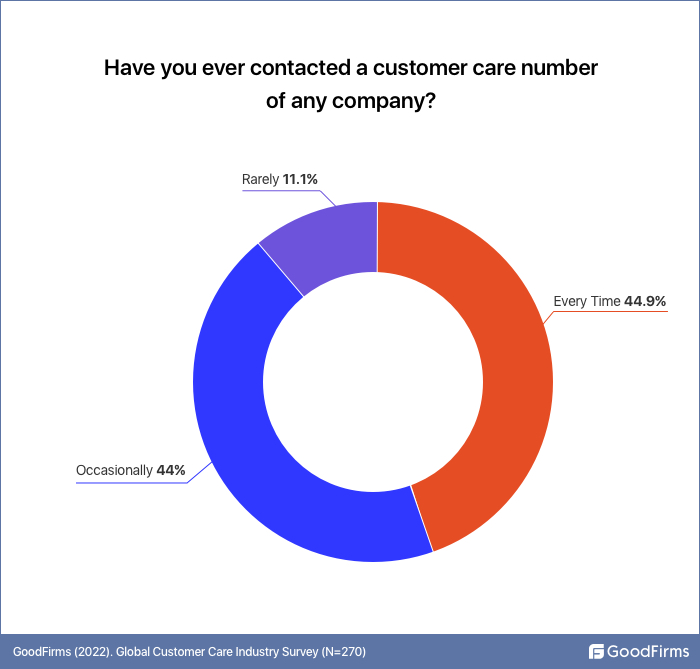
#Consumer Trends in Global Customer Care Industry
Phone is the Most Preferred Channel to Connect with Customer Care and Support:

25.9% Surveyees Prefer Phone Over any other Medium to Reach Customer Care:
Phones retained the top spot among mediums to reach the customer care services. 25.9% of surveyees prefer phones over any other medium to connect with customer support. Most of these people include people aged 40-59, who tend to stay away from the digital world. A small section of people aged 25-39 also use phones to connect with customer support.
22.2% of Surveyees Prefer Live Support Over Any Other Medium

This 24*7 live support is critical for any business to resolve customer issues and problems. It lets consumers connect with customer care anytime through different channels, enhancing customer satisfaction. Companies such as Apple are providing 24*7 customer support to their customers for almost every product and service bought from their online stores.(4)
In addition, factors like the responsiveness of the service rep, perceived wait time, system perceived ease of use, etc., impact the customers because all-time customer care availability is essential for any brand. With 24*7 customer support, customers can easily get the answers to their questions in real-time without any delay.
“The customer care industry is constantly evolving. In recent years, there has been a shift from traditional phone-based customer service to digital channels such as live chat and social media with 24 hour customer assistance services. This trend is likely to continue, as more and more customers prefer the convenience of digital channels,” says, Linda Shaffer, CPOO, Checkr
Email is the preferred choice of 10.1% of respondents, mostly between 25-39.
Email is the preferred choice of many people presently. Customer support through e-mail offers several unique benefits. First is that, consumers can interact on their terms via e-mail without any talking. Second is that the conversations through e-mail are readily available across multiple devices. Third is that, important documents and multimedia can shared through email as per necessity. In addition, easy access to email is also high as both people and businesses can read and reply whenever they want.
11% of Respondents Use Self-Service tools to Resolve their Issues
Self-service is also trending in the global customer care industry at present. It helps cut the loads of existing team members that can be used elsewhere. With self-service, consumers can identify the problems and their solutions with the help of chatbots and other knowledge bases/repository technologies. Artificial intelligence, Machine learning, Big data, etc. technologies are being used by different brands and organizations to develop self-service systems for their customers. People expect brands to provide an online self-service portal to resolve issues quickly.
Self-service is playing a very crucial role in the present times due to the convenience and rapid assistance. Most digital users use cell phones for their inquiries, including customer support.(5) Due to this, businesses are opting for mobile-centric self-service solutions with omnichannel support to serve their customers through different channels on mobile phones.
17.4% Stated That They Prefer Virtual Assistants When it Comes to Connecting With Customer Support
With the rise of Artificial intelligence and machine learning, virtual assistants are becoming more and more popular. Virtual assistants are used by businesses for customer service purposes, such as handling phone calls, training, and onboarding assistance. These are not only helping in assisting the customers but also improving the level of customer service for enhanced satisfaction. These virtual assistants are also increasingly used by businesses in their customer care services, making resolving customer issues easy. Chatbots are most popular virtual assistants. 48.1% of surveyees find chatbots helpful in identifying problems.

Only a small number of people, i.e., 37%, stated that they only talk to executives when the virtual assistants do not have relevant information on the menu. Therefore, businesses must conduct proper research before setting commands on virtual assistants. Virtual assistants benefit the brands in different aspects such as shopping cart management, generating invoices, processing refunds and returns, etc., which saves a lot of time for businesses.

29.6% Prefer to Fix Minor Issues by Conducting Secondary Research on the Internet and User Manuals.
There are a few customers who take the alternate route. Before contacting customer service, such type of customers try to fix issues themselves.To ensure the availability of self-service for users, the brands need to provide sufficient information regarding the common issues of their products and services. This information can be provided with the assistance of FAQs, Podcasts, a buyers guide, video tutorials, blog articles, product demos, etc. Businesses are providing how-to-use guides and tips to resolve minor issues on different digital platforms, including websites, youtube videos, etc. A brand's digital presence is another major driving force for ensuring the availability of secondary sources on the internet regarding the common issues of people.
Responsive Customer Services Are Bringing a Change
51.9% and 44.4% of respondents to GoodFirms' survey state that they consider their customer care experiences reliable and useful respectively. Most of these respondents use digital platforms in their food ordering, shopping, traveling, etc. Responsive services means the speed at which brands are responding to the issues and needs of customers. Many factors are impacting the response time of customer services such as communication and collaboration issues, frequency and consistency in final resolutions, etc. Customers and businesses are becoming more impatient and demanding due to which speed and accuracy of the service delivery are the major focusing factor of responsive customer services.
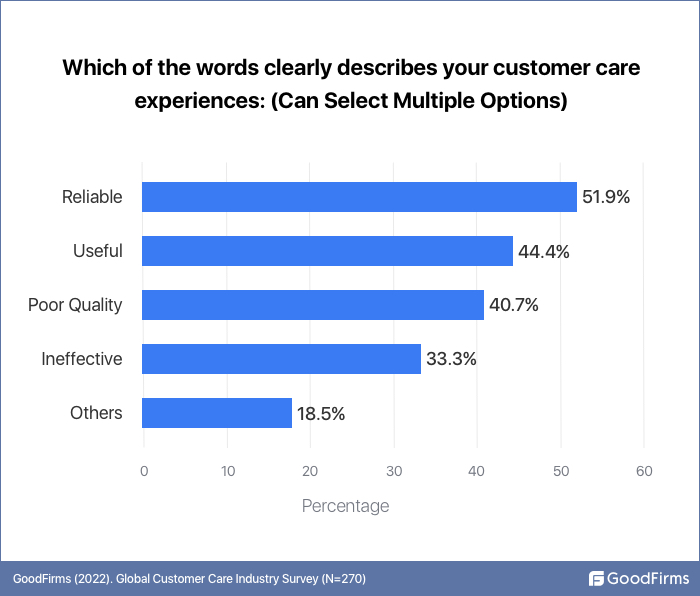
“Customers may pick from various goods and are exposed to offers, deals, and hooks via several media. When they make a decision, they want it immediately. Speed and ease of use are equally as crucial as the product itself. Brands that fail to deliver on time risk losing a potential customer's loyalty and any possible sales. says, Sam Willis, Founder, Rain Catcher.
Digital Platforms are Leading in Customer Care Services
Ecommerce, food delivery platforms and travel and tour aggregators emerged as the top three sectors that serve the best customer services. These sectors primarily operate via sophisticated digital platforms. Such sectors usually invest nominal amount of funds in physical stores and infrastructure instead they operate through online platforms. Majority of the businesses from Ecommerce, food delivery platforms and travel and tour aggregators sectors works in partnerships with brick and mortar businesses like restaurants, hotels, shops, etc. They only need minor physical infrastructure for datacenters, office and warehouses as the partners have the required products and services. Without major offline presence and no expenses associated with brick and mortar stores, these sectors can afford more investments in customer services.

66.7% like customer care services in the E-commerce segment
E-commerce platforms such as Amazon, eBay, Walmart, etc., are well flourished brands in the US market. The main reason behind the popularity of these platforms is the trust and loyalty-driven customer care services. The staff of such companies provide24*7 customer support to the customers, which enhances their experience. In addition, these giants' return and refund policies are also very impressive, with instant refunds and returns in case products are not upto the mark. Well trained staffs are capable of offering exceptional services. Many of the brands successful today have well trained customer care employees who can offer instant support to the users. For example, by 2025, Amazon is expecting to invest around $1.2 billion in the training and other development programs of employees for their skill and career development.(6) Through this, employees can work more efficiently for serving customers in a better way.
55.6% think that the Food delivery segment serve the best customer services
Food ordering and delivery platforms such as Uber, Postmates, Deliveroo, Grubhub, etc., are known for their customer care services.(7) Such platforms deeply research fees, delivery, variety of dishes and restaurants, the taste of the food, customer service, etc., to ensure better service delivery. In addition, these companies also have a standard and networked structure for resolving customer grievances.
40.7% prefer the customer services of the Travel and Tourism Aggregators
Customer care services of the Travel and Tourism industry are also popular among customers. Such companies take feedback from customers regularly to understand their areas of improvement. After careful consideration, companies choose the best destination with the best facilities to retain their consumers. Also, they ensure proper refunds and rewards without delays in case of poor user experience.
Personalized Customer Experiences are Here to Stay
Personalized customer experience is one of the most influential trends positively impacting brands and businesses. Presently, it is common for organizations to collect their consumers' personal information for different purposes. Then, this collected data is analyzed and recorded through technologies such as Artificial Intelligence and Machine Learning to provide tailored services as per consumers' needs and demands. Through personalized experience, consumers often feel valued and satisfied, resulting in better brand loyalty. In addition, personalizations allows better and faster delivery along with scalability and affordability. 36.8% of respondents do not prefer waiting in lines while connecting with customer support. Personalized customer experiences can positively impact such people who avoid waiting lines.

“One of the most significant customer service trends that improves customer loyalty and brand reputation is personalized customer interactions. For a business to strengthen its customers' relationships with its brand, a personalized customer care approach is always effective.” says Chris Smith, Director of CompareTV.
Customers are going with brands serving tailored and customized experiences in every aspect of their business, i.e., from sales to support. Offering a personalized customer experience is a big trend practiced by many businesses today to retain their customers. One such example is Amazon Prime Wardrobe. Amazon recently launched a wardrobe feature for their prime customers to enhance their experience.(8) In addition, prime users of Amazon also get tailored customer support as per their orders and transactions.
Top Changes Customers Would Like to See in Customer Care Services
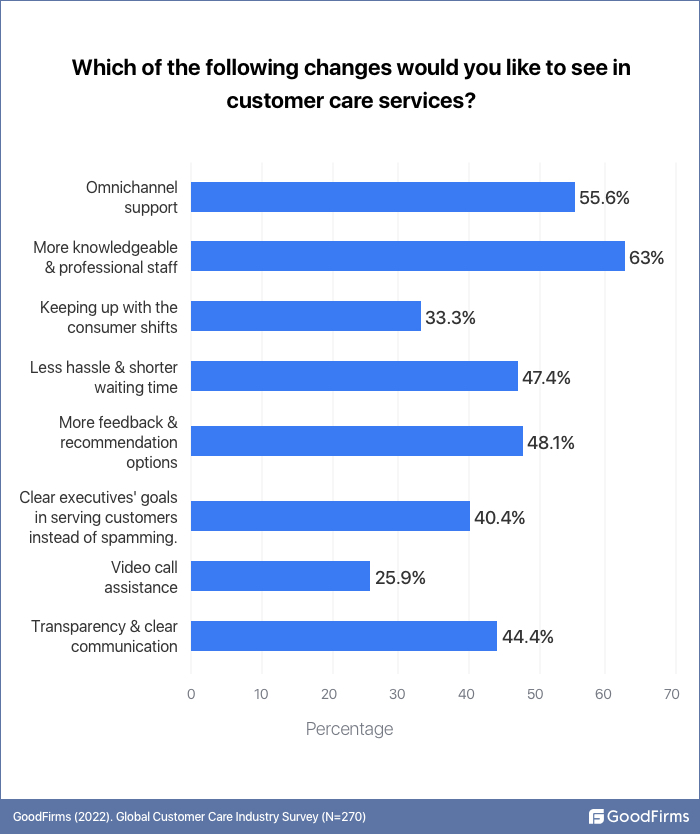
55.6% Suggested Omnichannel Customer Support
Omnichannel support refers to the tactics of using an integrated and seamless network of different touchpoints and devices for customer services and care. Businesses with omnichannel support consistently maintain a good reputation and positive customer experiences. The main cause behind the rise of omnichannel customer support is the growth of digital communication platforms such as social media, mobile applications, SMS, websites, etc. With the increasing popularity of these channels, customer expectations are also rapidly changing.(9)
Omnichannel support is becoming popular among the masses for the following reasons:
- Offers convenience and speed for greater customer loyalty.
- Helps activate and innovate new channels more quickly for seamless customer experience and interactions.
- Streamlining customer support through digital tools.
- Customizing user experience by leveraging insights on customer preferences.
- Creating new value through connected products and consumer data.
Most medium and large corporations use omnichannel customer support through social media platforms, emails, SMS, phone calls, etc., to ensure customer connectivity. Omnichannel presence is also vital for any business to interact with the customers who just went to social media for venting bad about the services.
25.9% of Surveyees Desire to Experience Video Chat Assistance
It is often frustrating for customers when they cannot reach someone for solutions to their issues. This is where video chat assistance comes in handy. Video chat assistance provides human elements instead of automated responses and faceless conversations. Video chat assistance is becoming popular as it helps in rising above the competition and combat the growing challenges of customer care.
“Customers will be able to avoid lengthy IVR loops, long hold times, and overall operational expenses by using this new technology. Agents will be more empathic and build connections with clients if they interact with them face-to-face. The most recent video chat software applications are browser-based and compatible with a wide range of different devices. You may use video chat to set yourself apart from the competition by customizing customer service to meet the needs of the new generation,” says Vincent Amodio, Founder, Icon Medical Centers.
In addition, video chat assistance is also used by businesses because it makes conversations personalized and interactive for a great user experience. Consumers do not want to waste much time, so they prefer video chat to get faster responses from their brands.
48.1% of Respondents are Expecting More Feedback and Recommendation Options
Currently, users wanting to provide feedback use internal feedback links provided by the brand on their website, social media pages, Google business page, etc. Some users also use third-party review platforms to submit feedback. 48.1% surveyees expect brands to provide more feedback and recommendation options to them.
The present age is full of tools and technologies through which brands are poised to deliver excellent customer services. These tools and technologies are used to determine consumers' preferences and wants. Businesses are using feedback and suggestions for properly acquiring detailed information regarding the different types of issues experienced by consumers. Some prominent brands currently use emails, forms, and complaint systems so that customers can easily voice their concerns. Through these tactics, organizations are collecting relevant insights regarding the offerings' positive, negative and ugly aspects.
These insights are then analyzed, and necessary actions are taken to genuinely deliver what their customers want. Feedback and suggestion from consumers also has another advantage: customers feel valued when their insights are used in product improvements and processes.
Consumer Shifts in 2022
At present, digital technologies are disrupting almost all sectors, including customer support and the care industry. In addition, other factors like the COVID-19 pandemic, the rise of new platforms, etc., are also increasing customer shifts. Some of these significant factors behind consumer shifts are as follows:
47.4% prefer less hassle and shorter waiting time
From standing in waiting lines to multiple interaction touchpoints, consumers' perceptions are changing drastically, and they desire everything as soon as possible. Digital technologies such as Artificial intelligence, machine learning, IoT, etc., are hugely assisting businesses in the customer care industry to tackle these shifts. Brands are using these technologies to instantly interact with customers and provide hassle free support and experience..
A few years back, phone calls and physical store visits were among the significant popular channels for interacting with customer care. However, with the revolutions in communication technology, people are shifting towards new channels such as live chat, social media, etc.

55.6% state that customer care services have worsened after the pandemic
The recent pandemic also led to some positive and negative impacts on consumers. While the businesses remained in losses most of the time, consumers also experienced problems on different levels. Initially, consumers were sympathetic to companies for late deliveries of products and services, but with time, it became a headache for the consumers. Due to the unavailability of workers and lockdowns, consumers' waiting time keeps increasing.

Almost every business, whether B2B or B2C, has undergone several changes in its sales approaches and customer support service over the last few years. After the pandemic, some consumers had to keep trying several times in order to connect with customer support. In addition, the pandemic has accelerated the shift to digital across industries.
70.4% of respondents shifted to alternate brands due to poor customer care service
Customer retention has become one of business organizations' most hectic and costly factors. When the services are not satisfactory, customers opt for alternate brands to fulfill their needs. People are moving towards new and latest digital channels for better product expectations. Globalization is also one of the major factors due to which new products are reaching new markets, leading to the growth of businesses and the customer service industry. It is very critical for any company to have an entire-fledged team working to resolve the issues of their customers if they want to retain their customers from switching.

48.1% recommend the brands to others if customer care is satisfactory
When people find customer care service of any brand good, they are likely to suggest the brand to their relatives and friends. However, when services are unsatisfactory, then they switch to alternate brands. Therefore, brands need to ensure that their customer care services are streamlined and efficient to ensure customer satisfaction at a higher level.

Challenges in Customer Care Industry
Tackling Customer Disengagement
Whenever consumers encounter issues with their products and services, they want to connect with customer care professionals to resolve the problems quickly. However, not all businesses can provide quick customer support due to low availability or the number of employees. This impacts their perceptions and views regarding the brand, resulting in disengagement. Therefore, it is very vital for any business to either have their in-house team, or they should outsource their customer support.
40% of the surveyees mentioned they have in-house teams for customer support, whereas 16% outsource their customer support services.
"We have an in-house support team for now, and we use a live chat feature on our website with artificial intelligence built in so that it routes customers to the correct place. Customer care is an important part of my service and it's not something that I would outsource to low-cost operators who just want to close tickets," says StephanieVenn-Watson, Researcher, Fatty15
The Rising Cost of Customer Support Practices and Maintenance Tools
The world is changing, and so does the cost of different products and services. The average inflation rate of the dollar in 2010 was 2.59% and has risen to 35.89% in 2022. This states that the prices of different things are much higher now when compared to the prices in 2010.(10) From the salaries of employees to customer support tools, prices of almost everything are rapidly increasing, resulting in increasing costs for the businesses.
In addition, customer expectations are also changing due to which brands maintain their customer support presence on almost all platforms, including text, SMS, emails, social media, etc. Furthermore, customer service tools and software are becoming costly with time and features that also impact the brands. These factors pose more challenges for businesses in ensuring proper customer satisfaction.
However, investing in these different aspects also benefits businesses as people prefer paying more for better services and features.

59.3% of respondents are willing to pay more for good customer support services.
Dealing With Demanding Customers/Managing Expectations
With time and technological advancements, customer needs and expectations also keep changing. Some customers stay happy with the services, whereas others are demandable. This is a significant challenge for the customer service industry, which is preventing the industry's growth. Some customers also request solutions that are not covered under customer support. The customers sometimes desire extra features, discounts, etc., which customer care representatives fail to offer. Various measures are being implemented across the global markets to deal with these dynamic expectations of customers. Some of these measures are as follows:
- Giving self-service opportunities through knowledge bases, FAQs, videos, bots, etc.
- Use empathy during the interaction to avoid escalation of the issue
- Asking for reviews and feedback to let them feel valued
“The biggest challenge that customer care executives face is dealing with demanding customers. These people are not satisfied no matter what you do. They may be rude, aggressive, or even verbally abusive. Dealing with these customers can be very stressful and can take a toll on your customer service skills.” says Joey Sasson, Vice president at MovingAPT in the US.
Staying Conversant With New Technologies and Trends
It is not easy for businesses to stay competitive in the market without using new trends in tech and business. Whenever any new technology or trend comes into the market, organizations must change their processes, work, etc. They must adapt to the change while simultaneously serving the customers through support. In addition, massive research and studies are done to determine the potential impacts of the latest technologies on business and customer support. Businesses must get acquainted with these research outcomes and try to implement the findings in their customer care processes. Business organizations must also ensure that their employees are well versed in digital skills too so that new trends and technologies can be used to optimize the customer journey from start to end.
In addition, 40.7% of respondents feel that businesses should develop their products with the best quality to avoid issues. Therefore, leveraging the new technologies is beneficial in developing improved products and services to reduce customer issues.
Inadequate Training and Poor Knowledge Among Representatives
Employee orientation and workspace training are the most important aspects through which employees acquire information regarding the company and its offerings, culture, etc. In addition, most of the freshers in this industry do not possess the required skills and knowledge for serving effective and best services to customers. In addition, due to their lack of knowledge, they often encounter issues in understanding the situation of customers, leading to consumer shifts.

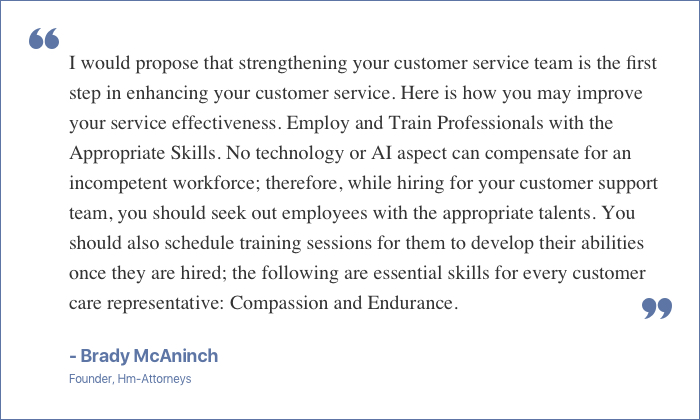
63% of surveyees would like to see more knowledgeable and professional staff in the customer care services. Any organization needs to provide training and development sessions for employees through which customers can be efficiently handled with best practices. Through these training and development sessions, they can acquire the ability to resolve the customer's issues.
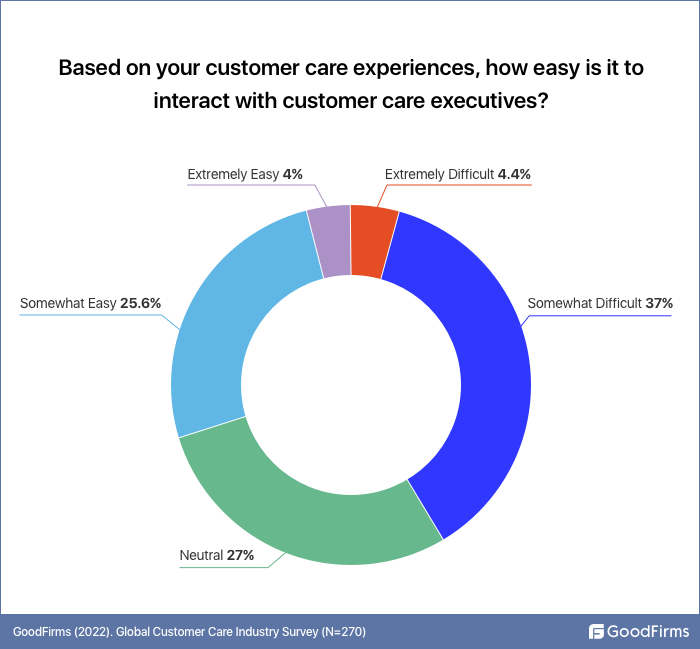
In addition, 37% of respondents said they find it difficult to interact with customer care executives. Training and development sessions are helpful in such cases so executives can adequately interact with customers transparently.
Lack of Standard Operating Procedures
Consumers use different methods such as calls, emails, live chats, etc., to resolve their grievances. Therefore, it is crucial to maintain the data of these grievances systematically. Some businesses lack a standard operating procedure, so people's complaints are not resolved promptly. The complaints either stay pending in email inboxes and voicemails, or the customer care officials do not record them. In some cases, data is also misplaced, which confuses both representatives and customers. This negatively impacts the customer perceptions resulting in dissatisfaction.
40.4% of surveyees would like to see clear goals of executives in serving customers instead of spamming. With standard operating procedures, executives can help the customers better, reducing spamming and leading to a positive customer experience.
Taking too Much Time for Resolutions
Consumers prefer fast services in this digital age and don't want to waste time resolving their problems. Sometimes, customer care representatives take much time to resolve a case, due to which the customers get annoyed. Moreover,executives fail to narrate the whole situation to customers, making the case more complicated. In such cases, it is the responsibility of representatives to describe the complications to consumers and prevent the escalation of the problem. Even if it is taking time due to legit reasons, customer care executives need to inform the customers regarding the updates and moves.
Key Findings
- 25.9% of surveyees prefer phones over any other medium to connect with customer support
- The live chat feature is one of the significant trends, preferred by 22.2% of respondents.
- Self-service is the preferred choice of 11% in resolving their issues.
- 26.6% prefer to use secondary research to resolve their support concerns.
- Virtual assistants are trending as they provide quick information and resolution of issues.
- 55.6% of customers want omnichannel customer support from brands.
- Video chat assistance is another known trend in the global customer care industry.
- 48.1% consumers are expecting more feedback and recommendation options, a recent popular trend.
- Responsive customer support and digital platforms are currently leading in customer care trends.
- E-commerce, food delivery, and travel segments are popular among the masses due to their best customer service.
- Personalized customer experience is also dominating the global customer care industry at present.
- Customers' habits and preferences rapidly change, leading to several consumer shifts.
- The COVID-19 pandemic has worsened customer care as per 55.6% of respondents.
- 70.4% of respondents shifted to alternate brands due to poor customer care service of the existing brands.
- 48.1% of surveyees recommend their preferred brands to others if their customer care is satisfactory.
- Handling rising costs of the customer care processes and tools is an important challenge in the customer care industry.
- Businesses prefer in-house customer care teams compared to outsourcing.
- The customer care industry is also experiencing issues handling demanding customers and newer technologies.
- 37% of respondents find it difficult to interact with customer care executives due to poor or irrelevant knowledge of the representatives.
- 40.4% of surveyees would like to see clear goals of executives in serving customers instead of spamming.
- Lack of time and coordination among customers and representatives is another major challenge impacting the industry.
Conclusion
Exceptional customer care services can offer tremendous growth opportunities to businesses in the upcoming time. With the economic recovery in sight, the global customer care industry is expected to grow consistently. There are several areas in which customer care services will help develop close relationships between brands and customers.
As per GoodFirms’ survey, consumers switching to alternate brands, unpleasant interactions, long call waiting times, diverting the call to different departments, etc., are impacting the customers’ experiences. In addition, the majority of the respondents to GoodFirms’ survey stated that there is a dire need for brands to have knowledgeable employees with transparent systems.
By handling the challenges through innovations in customer support processes, and building the knowledge and expertise of the employees, businesses can implement the best customer support practices. By adopting these systematic practices, they can develop long-lasting relationships with consumers, improve their products, increase customer loyalty, increase market share, etc. Undoubtedly, these benefits can drastically improve their business growth.
We sincerely thank our Research Partners who participated in the survey.
References
- https://www.grandviewresearch.com/industry-analysis/customer-experience-management-market
- https://www2.deloitte.com/uk/en/pages/digital-transformation/articles/delivering-customer-service-during-COVID-19.html
- https://www.gminsights.com/industry-analysis/outsourced-customer-care-services-market
- https://www.businessinsider.com/43-online-stores-that-offer-247-call-support-2012-7?IR=T
- https://www.perficient.com/insights/research-hub/mobile-vs-desktop-usage
- https://www.aboutamazon.com/workplace/upskilling-commitments
- https://www.goodfirms.co/resources/food-ordering-delivery-platforms-market-trends-opportunities
- https://www.mckinsey.com/industries/retail/our-insights/personalizing-the-customer-experience-driving-differentiation-in-retail
- https://www.ibm.com/cloud/learn/omnichannel-customer-service
- https://www.in2013dollars.com/us/inflation/2010?amount=15300&future_pct=0.0167





